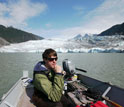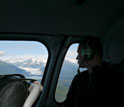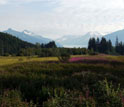News Release 12-030
Scientists Unlock Record of Ecosystem Changes Frozen in World's Glaciers
History of influence of industrial revolution hidden in glacial ice

Ice wall in Mendenhall Glacier, Alaska, contains frozen clues to environmental change.
February 19, 2012
This material is available primarily for archival purposes. Telephone numbers or other contact information may be out of date; please see current contact information at media contacts.
New clues about how Earth's remote ecosystems have been influenced by the industrial revolution have been uncovered. Until now they were locked away, frozen in the ice of glaciers.
So say scientist Aron Stubbins of the Skidaway Institute of Oceanography and colleagues.
They published results of their study in the March, 2012, issue of the journal Nature Geoscience. It shows that everything flows downhill, eventually.
The research was funded by the National Science Foundation (NSF).
The key to the process is carbon-containing dissolved organic matter (DOM) in glacial ice.
Glaciers provide large amounts of carbon to downstream ecosystems. Many scientists believe the source of this carbon lies in ancient forests and peatlands overrun by the glaciers.
However, Stubbins and others think the carbon comes mainly from modern biomass and fossil fuel burning that makes its way onto the glaciers' surfaces.
Once deposited by snow and rain, the DOM moves with the glacier and is eventually delivered downstream where it provides food for microorganisms at the base of the aquatic food web.
"In warmer ecosystems like in the temperate or tropical zones, once this atmospheric organic material makes landfall it is quickly consumed by plants, animals and microbial populations," says Stubbins. "But in cold glacier environments, these carbon 'signals' are preserved."
Remote regions often are perceived as pristine and devoid of human influence.
But glaciers show us that nowhere goes untouched, Stubbins says. Burning fuels has effects on ecosystems far removed from industrial activity.
"Because deposition of combustion products is a global phenomenon, all ecosystems may be receiving this 'subsidy,'" says Matt Kane, program director in NSF's Division of Environmental Biology, which funded the study along with NSF's Divisions of Ocean and Earth Sciences.
"Some aquatic systems previously thought to be pristine have, in fact, been affected by human activities for a century or more."
Glacier ecosystems cover ten percent of the Earth, yet how carbon moves through these ecosystems isn't completely understood.
"More knowledge of glacier biogeochemistry is a priority, as glacier environments are among the most sensitive to climate warming and the effects of industrial pollution," says Stubbins.
Globally, glacier ice loss is accelerating, driven in part by deposits of carbon in the form of soot or "black carbon," which darken glacier surfaces and increase their absorption of light and heat.
Biomass and fossil fuel burning by people around the globe are the major sources of black carbon.
Stubbins and colleagues have conducted much of their research at the Mendenhall Glacier near Juneau, Alaska.
Mendenhall and other glaciers that end their journey in the Gulf of Alaska receive large amounts of rain and snow. This precipitation acts to strip the atmosphere of organic materials, then dumps them on the glaciers.
Consequently, these glaciers are among the most sensitive to global emissions of soot.
The researchers' findings also reveal that the ocean may have changed over past centuries as a result of this process.
The microbes that form the bottom of the food web are sensitive to changes in the quantity and quality of carbon entering the marine system.
The scientists found that the organic matter in glacier outflows stems largely from human activities. This means that the supply of glacial carbon to the coastal waters of the Gulf of Alaska is a modern, post-industrial phenomenon.
"When we look at marine food webs today, we may be seeing a picture that is significantly different from what existed before the late 18th century," says Stubbins.
"It's unknown how this man-made carbon has influenced the coastal food webs of Alaska, for example, and the fisheries they support."
A warming climate will increase the outflow of the glaciers and the accompanying input of dissolved organic material into the coastal ocean.
The effects will be most clear in glacially-dominated coastal regions, such as those off the Gulf of Alaska, Greenland and Patagonia. These areas have the highest rate of glacier ice loss.
"It's not known to what extent organic material deposition has changed, and will continue to alter, glacially-dominated coastal ecosystems or the open ocean," says Stubbins.
"But glaciers will continue to provide a valuable and unique window into the role this deposition of organic material plays in a rapidly-changing environment."
Stubbins' collaborators on the project include Eran Hood and Andrew Vermilyea of the University of Alaska Southeast; Peter Raymond and David Butman of Yale University; George Aiken, Robert Striegl and Paul Schuster of the U.S. Geological Survey; Rachel Sleighter, Hussain Abdulla and Patrick Hatcher of Old Dominion University; Peter Hernes of the University of California-Davis; Durelle Scott of Virginia Polytechnic Institute and State University; and Robert Spencer of the Woods Hole Research Center.
-NSF-
-
Torrent of ice-water from Mendenhall Glacier carries organic matter to the Gulf of Alaska.
Credit and Larger Version -
Researcher Eran Hood ferries sample-laden scientists from Mendenhall Glacier to a lab.
Credit and Larger Version -
Scientist Robert Spencer looks down on Mendenhall Glacier from a helicopter.
Credit and Larger Version -
Glacier river flows into the Gulf of Alaska, carrying material that feeds the marine food web.
Credit and Larger Version -
What goes around comes around: glaciers flow into the sea, which washes onto the land.
Credit and Larger Version
Media Contacts
Cheryl Dybas, NSF, (703) 292-7734, email: cdybas@nsf.gov
Michael Sullivan, Skidaway Institute of Oceanography, (912) 598-2325, email: mike.sullivan@skio.usg.edu
The U.S. National Science Foundation propels the nation forward by advancing fundamental research in all fields of science and engineering. NSF supports research and people by providing facilities, instruments and funding to support their ingenuity and sustain the U.S. as a global leader in research and innovation. With a fiscal year 2023 budget of $9.5 billion, NSF funds reach all 50 states through grants to nearly 2,000 colleges, universities and institutions. Each year, NSF receives more than 40,000 competitive proposals and makes about 11,000 new awards. Those awards include support for cooperative research with industry, Arctic and Antarctic research and operations, and U.S. participation in international scientific efforts.
Connect with us online
NSF website: nsf.gov
NSF News: nsf.gov/news
For News Media: nsf.gov/news/newsroom
Statistics: nsf.gov/statistics/
Awards database: nsf.gov/awardsearch/
Follow us on social
Twitter: twitter.com/NSF
Facebook: facebook.com/US.NSF
Instagram: instagram.com/nsfgov





